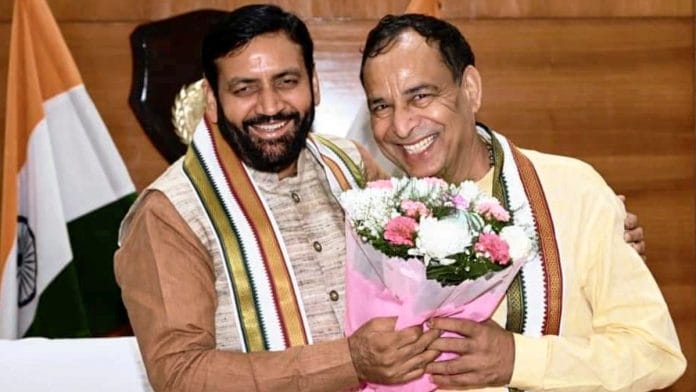Thank you dear subscribers, we are overwhelmed with your response.
Your Turn is a unique section from ThePrint featuring points of view from its subscribers. If you are a subscriber, have a point of view, please send it to us. If not, do subscribe here: https://theprint.in/subscribe/
The Bharatiya Janata Party (BJP) clinched a historic third consecutive term in the 2024 Haryana Assembly elections by winning 48 out of 90 seats. Despite pre-election predictions favoring the Congress, the BJP’s success was the result of a well-planned strategy centered around grassroots outreach, leadership adjustments, and voter segmentation. This article delves into the data and tactics that helped the BJP achieve this electoral milestone.
1. Seat Distribution and Vote Share Dynamics
In the 2024 elections:
- – BJP won 48 seats with a vote share of 39.9%, increasing from 36.5% in 2019.
- – Congress secured 37 seats, with its vote share jumping from 28% to 39.1%.
- – The vote shares of regional parties like the INLD and JJP shrank significantly, with their combined share dropping from 21% in 2019 to 7% in 2024.
- – Independent candidates secured only three seats but contributed strategically by lending post-election support to the BJP, pushing the party’s effective tally to 50 seats.
2. RSS and Grassroots Mobilization
A major factor behind the BJP’s victory was its renewed partnership with the Rashtriya Swayamsevak Sangh (RSS). Following the farmers’ agitation (2020-2021) that had dented the party’s rural appeal, the BJP leaned heavily on the RSS for voter outreach. The RSS conducted over 16,000 meetings and deployed 150 volunteers per district to rekindle grassroots support.
These efforts included:
- – Hosting chaupals (community meetings) to address grievances.
- – Strengthening ties with local leaders to counter anti-incumbency.
- – Ensuring that campaign efforts reflected the aspirations of rural voters, especially targeting regions that previously leaned toward Congress.
3. Leadership Transition and Caste Strategy
The BJP strategically replaced Manohar Lal Khattar with Nayab Singh Saini, an OBC leader, as the party’s face. This move aimed to consolidate the 40% OBC voter base, creating a broad coalition of non-Jat communities, including Punjabis, Brahmins, and Rajputs.
While Congress focused on uniting the Jat vote under Bhupinder Singh Hooda, the BJP succeeded in expanding its non-Jat base. Notably:
- – The non-Jat consolidation strategy proved effective in urban and semi-urban regions, including key belts along the GT Road corridor and industrial hubs like Faridabad and Gurgaon.
- – In rural areas, Saini’s outreach to khap panchayats and local community leaders mitigated dissatisfaction with the previous BJP administration.
4. The Impact of Fragmented Opposition
The BJP’s ability to secure 28 seats with less than 50% of the vote reflects how a divided opposition benefited the party. While both the Congress and BJP increased their vote shares, regional parties like the INLD and JJP were decimated, splitting the anti-BJP vote. Additionally:
- – The Congress struggled with infighting between leaders like Bhupinder Singh Hooda and Kumari Selja, which weakened its campaign and voter outreach efforts.
- – Dalit-centric parties also divided the anti-incumbency vote, undermining the Congress’s prospects in crucial constituencies.
5. Urban vs. Rural Performance
- – The BJP maintained its dominance in urban regions, capitalizing on the economic aspirations of voters in cities like Faridabad, Gurgaon, and Panipat.
- – In rural areas, the BJP’s outreach through beneficiary schemes and a focus on infrastructure development resonated with voters despite lingering discontent from the farmers’ protests.
6. Lower Voter Turnout
Voter turnout in Haryana decreased to 67.9%, down by 0.4 percentage points compared to the previous elections. Despite the lower turnout, the BJP managed to retain and even expand its base. Political analysts attributed this to the BJP’s ability to mobilize core voters effectively, even as opposition parties failed to convert their larger vote share into more seats.
Conclusion
The BJP’s 2024 victory in Haryana was a product of strategic leadership changes, effective grassroots mobilization, and successful voter consolidation. The party’s alliance with the RSS, focus on non-Jat votes, and partnerships with independent candidates enabled it to overcome anti-incumbency and opposition challenges. Meanwhile, the Congress’s internal discord and fragmented vote base further paved the way for the BJP’s triumph. As Haryana looks ahead, the BJP’s victory underscores the importance of coalition-building and grassroots engagement in modern electoral politics.
These pieces are being published as they have been received – they have not been edited/fact-checked by ThePrint


